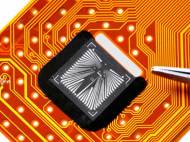Lab on a chip for sweat testing and monitoring
 Collaboration between EPFL’s Nanoelectronic Devices Laboratory (Nanolab) researchers and startup Xsensio resulted in development of a low-power and portable sensing chip. The chip can be put directly on skin, or integrated into wearables in order to track real-time different biochemical and physical parameters in a person’s sweat. Xsensio was founded in 2014 as a spinoff of the Nanolab to capitalize on the long expertise in development of nanosensors.
Collaboration between EPFL’s Nanoelectronic Devices Laboratory (Nanolab) researchers and startup Xsensio resulted in development of a low-power and portable sensing chip. The chip can be put directly on skin, or integrated into wearables in order to track real-time different biochemical and physical parameters in a person’s sweat. Xsensio was founded in 2014 as a spinoff of the Nanolab to capitalize on the long expertise in development of nanosensors.
The tiny (less than 1 square centimeter) sensing chip collects sweat from the surface of the person’s skin and tracks biochemical data contained in it in a non-invasive way. For example, the chip is able to determine the level of different metabolites, small molecules, proteins, electrolytes such as sodium, potassium, chlorine, and measure body temperature as well as pH level. The data collected by the chip can be sent via a wireless antenna to a smartphone.
The collected information can serve as important indicators of wearer’s health and wellness. Many of the biomarkers available in blood are also available in sweat, and it has been shown that some conditions are associated with changes in levels of biomarkers available in sweat. Measurements of chloride level as well as pH in sweat are important indicators of hydration levels. The chip could potentially be used to diagnose the lung disease cystic fibrosis by analyzing the chloride content in sweat. Also, measuring the levels of other biomarkers can indicate symptoms of fatigue, stress and drug abuse and eventually even risk factors for other illnesses.
The sensing device has four silicon 20-nanometers thick and very sensitive sensors, each of them coated with a different material. Therefore, each sensor detects specific biomarkers.
“Our platform is truly modular. By depositing different biochemical layers on each of the miniature sensors, we can measure a host of variables ranging from electrolytes and metabolites to tiny molecules and proteins. That gives users personalized real-time data”, said Esmeralda Megally, CEO of Xsensio.
The sensing device has two fluidic layers, located between the chip and user’s skin, that pump up sweat from the user’s skin and move it to the sensors. Capillary action is used to pump extremely small amounts of sweat into the heart of the sensing chip where sweat is further analyzed. Due to passive capillary collection system, the chip analyzes content of sweat continuously and without electricity.
“Ours is the only device out there that includes such a system on a chip”, said Professor Adrian Ionescu, head of the Nanolab. “Even today’s most advanced devices use sensors that are 10,000 times bigger than ours, and need a larger volume of sweat to be able to effectively analyze biomarkers.”
The sensor technology developed by Nanolab’s s is equal to the technology used in computer microprocessors. The startup Xsensio developed capillary nanofluidic channels interface with user’s skin and the different biochemial layers that enables detection of specific biomarkers.
The chip was presented in December 2017 at the 63rd International Electron Devices Meeting (IEDM) in San Francisco. In order to release it into consumer market, the researchers plan to integrate the sensing chip into a wearable device such as bracelet that could be used for 24/7 monitoring.









Leave your response!